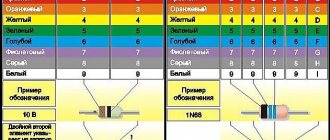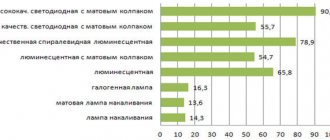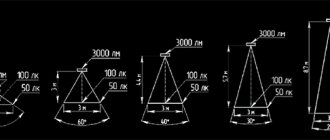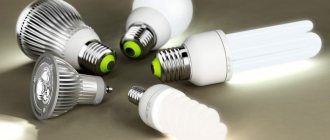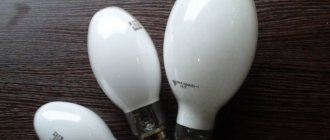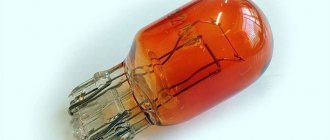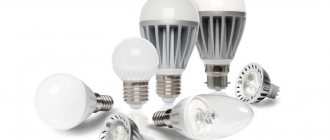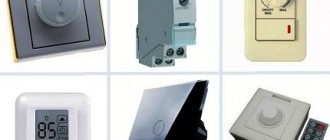The socket is the part of the lamp that connects it to the socket. The products ensure a tight fit of the contacts through which the lamp receives power. All existing cartridges are divided into categories and can only work in tandem with a lamp that has a suitable base.
Therefore, when choosing a lighting device, first of all, pay attention to this parameter. We suggest you understand what types of LED lamp bases there are, what are the specifics of using various devices, and how to choose the appropriate option.
Types of LED lamp bases
One of the criteria by which LED lamps are distinguished is the type of base. All of them can be divided into two volumetric categories - threaded and contact. There are many types within the groups, but among them there are five most popular.
E27 . Used for all standard lamps, and for those where the luminous flux exceeds 1200 Lm, only this type is used. As a rule, E27 lamps operate in alternating current conditions and at a voltage of 220 V.
E14 . Suitable for all types of standard lamps, but with miniature sizes. Lamps with E14, which are also called “minion”, have interesting shapes: candle, mushroom, ball.
GU10 . Has a two-pin connector, swivel mount. They are used for ceiling lighting fixtures in the form of LED lamps with standard size MR16.
The light source placed in the cartridge is held in place by a special lock, which is why they are in demand in places where vibration or other external influences are observed.
GU5/3 . Used in luminaires with lamps powered by LEDs, reflector type MR16 for decorative lighting. They are powered by both 220 and 12V mains.
G13 . Used for tube-shaped lamps T-8 and T-10. They are installed in ceiling panels, which are most often found in office spaces for targeted lighting of work areas.
Before purchasing a new lamp for your lamp, you need to decide on the type of base used in it. There are many types of these elements and not all of them are interchangeable (+)
The first two types are threaded. To connect a product with such a base and a socket, it is screwed in like a simple incandescent lamp.
The remaining three types are contact or pin. These sockets are equipped with pin-shaped terminals located on the edge of the lamp.
Less popular threaded sockets are E10, used in lamps that illuminate the interior of refrigerators, and E42 - for street lamps.
LED luminaires, widely used by designers, are equipped with adapter elements G4, GU4, G9.
Features of holders
Threaded
This type of connector is used in almost all lighting fixtures in the house - from chandeliers to wall sconces. The adaptation of LED lamps to this type of base has contributed to the gradual decline of incandescent light bulbs and housekeepers into the past. The threaded holder itself is connected to the light bulb with strong glue. Because of this, you should be extremely careful when replacing a failed copy. If the base remains inside the socket, it is best to use pliers to remove it.
Pin
The LED connector marked G, in comparison with its halogen “brother,” gives a brighter glow, lasts longer, hardly heats up, and “eats” little energy. Often, to coordinate the light flux in one desired direction, a reflector is mounted in lamps with a threaded LED holder. Ceramic G sockets with reliably insulated wires are widely used.
Characteristics of threaded holders
Threaded products are the most popular options for plinths. They equip floor lamps, table lamps, lamps, and lanterns. In sconces, small table lamps, hanging lamps and chandeliers, E14 lamps are often used.
LED lamps with such an adapter are gradually replacing incandescent lamps and “housekeepers” from household use.
A light source with an E27 base is a more advanced analogue of a 90 W incandescent lamp. With 11W of power, it produces the same illumination as its more powerful prototype
For high-power luminaires, E40 sockets are most suitable. They are used in industrial workshops and in street lighting.
There are also less popular types of threaded bases:
- E10 , E12 , E17 - small with diameters of 10, 12 and 17 mm, respectively;
- E5 - microscopic with a diameter of 5 mm;
- E26 - medium.
The threaded base is attached to the flask using an adhesive connection. If you need to replace the lamp, you need to do it carefully, otherwise the base may break off. If this does happen, you need to turn off the power to the lighting fixture.
The next thing to do is to carefully unscrew the damaged base using pliers. It is better to avoid such situations when replacing the lamp, it is recommended to rub the thread with graphite.
LED lamps depending on the color temperature of light
When considering the types and characteristics of LED lamps, one cannot help but dwell on such a parameter as the color temperature of the light. Despite the word “temperature,” this concept has absolutely nothing to do with the heat generated by the light bulb. It means the visual perception of the color spectrum of light that the lamp emits.
Therefore, there is no need to confuse physical and color warmth. Color temperature is measured in Kelvin, which for LEDs can reach readings of up to 7000 K.
Warm light
There are certain rules for choosing LED lamps. Depending on the purpose of the room, lamps with suitable heat are used. For example, lamps with temperatures in the range from 2500 to 3500 K, which have a “warm light”, create a comfortable atmosphere. Yellow color, similar to the light emitted by an incandescent lamp, is suitable for recreational areas.
Daylight
Fluorescent lamps with temperatures in the range of 4000 to 5000K have a neutral color emission and are used primarily in work areas. They are well suited for the desktop, kitchen, bathroom.
Cold light
The brightest cold light is emitted by lamps with temperatures above 5500 K. Such lamps are installed in places where it is necessary to maintain an energetic state: in workshops, garages, etc. However, if you stay under cold lighting for a long time, you may feel tired.
Features GU10, GU5/3, G13 and G23
GU10 . In LED lamps, the GU10 holder is designed non-standardly. At the ends of the contacts it has extensions that firmly hold the lighting element in the socket.
The base of this type is pin. Its contacts are located at a distance of 1 cm. The addition in the form of the letter U indicates the presence of design features of the device (+)
An LED light source with this base, along with the same parameters as its halogen counterpart, has a number of advantages.
It has more intense light, a significantly longer service life, and minimal energy consumption. The main advantage is that it practically does not heat up.
Devices with a GU10 socket are powered from a 110-220 V network. Typically, lamps with such a holder are equipped with a reflector to give the light a certain direction.
A limited number of manufacturers produce low-voltage lighting elements. This is explained by the narrow scope of demand - a purely local lighting system.
Designers use them for interior lighting. They are ideal for splot lighting fixtures.
GU5/3 . The GU5/3 ceramic base contains wires enclosed in a protective sheath. Imported products are operated at a voltage of 12/24 V.
But in Russia, lamps with such a base, adapted to the usual 220 V, are more common. They are connected to the network via terminal blocks, which is more reliable.
The G4 pin base is often present in small spotlights that are used in decorative applications.
G4 LED lamps are often used to replace low-voltage halogen lamps in chandeliers.
The contacts are spaced 5.33mm apart. Fluorescent lamps using GU5/3 are an analogue of multifaceted halogen reflectors and are energy saving.
G13 and G23 . They are installed not only in T8 LED lamps, but also in lighting fixtures such as Armstrong, LSP, and others. The distance between the contacts is 1.3 cm.
G23 are for "U" shaped lamps. A starter is included in its design. Starting is carried out using a choke, usually located in the luminaire body. The power of such devices ranges from 5 to 14 W; they are screwed mainly into table lamps.
Types of LED lamps by application
LED lamps for home
LEDs are increasingly replacing incandescent lamps, as well as fluorescent and halogen counterparts. They are similar in design to their predecessors, that is, they are a bulb on a standard base, suitable for any lamp. They are used to provide lighting in any type of premises: residential and public buildings, offices.
LED lamps for outdoor use
The main purpose is to illuminate houses, illuminate streets, private areas, park and garden areas, roads, etc. Outdoor LED lamps are produced using anti-vandal technology with an increased degree of protection (IP rating). Design solutions for outdoor LED structures allow not only to diversify lighting, but also to give objects an aesthetic appearance.
LED lamps for plants
LED lamps (Grow light) are successfully used for growing seedlings, indoor flowers, and greenhouse crops. When manufacturing lamps, the radiation spectrum with ultraviolet light is specially selected, which accelerates the growth and development of plants. The ability to program allows you to achieve differentiated illumination depending on operating conditions.
LED lamps for decoration
Such lamps are intended not so much for lighting, but for decoration and highlighting the style of the interior. A small dispersion angle and a wide range of colors allow you to create a cozy atmosphere and highlight areas in the room.
LED spotlights
LED floodlights are widely used today in private households. Due to the increased cost, until recently such lamps were rarely used. However, with the development of technology and decreasing prices, floodlights with a specific direction of light and a suitable dispersion angle have become more in demand.
Pin bayonet socket
There are special pins on the body of this connecting device. With their help, the base is connected to the cartridge. When developing the product, a specific goal was set - to make the lighting fixture more compact in shape and reduce the time needed to replace light bulbs.
Round side pins (2 pcs.) are located symmetrically on the base. They are secured in the slots of the cartridge intended for this purpose, and then turned ¼ turn for better fixation.
The photo shows an LED light bulb with a bayonet base, marked BA15D. lamp dimensions - 22*60 mm, voltage - 0.5-1 V
One type of pin product is the BA base with asymmetrical side contacts. It is used in cars. The unique design allows the lamp to be inserted into the socket in a special way and focus the luminous flux of the headlights.
In some countries, mainly English-speaking, pin connectors are designated BC, short for Bayonet Cap, in Europe - B22d, in Russia - 2Ш22.
The analogue of the European B15d is the domestic 2Ш15 and in English - SBC, the full name is Small Bayonet Cap. MBC/MBB corresponds to Russian 1Ш9 and European Ba9s.
Lamps with G4 socket
This type of LED lamps is characterized by small dimensions (3cm in length and 3cm in diameter).
The main difference between this light bulb and the previous ones is that it operates from a special 12V power supply.
The pins of the G4 base are much thinner and longer than those of the G9 lamp.
The distance between them is 4 mm.
Such lamps are most often used to illuminate boats or yachts. They are inserted into special reflector lamps.
All LED lamp bases have different characteristics. They must be selected taking into account the type of socket in the lamp, as well as the required luminous flux power.
Rarely seen holders
Some types of these integral elements of a lighting fixture are quite rare. These also include devices with recessed contacts.
Characteristics of rare types of base
With recessed contact . Belonging to this species is indicated by the presence of the symbol “R” in the marking. They are used in lamps of small dimensions and light weight.
Soffit "S" . There are options for placement on one side of the tubular lamp, or on both. Such sockets are appropriate in lamps used as mirror illumination, in bathrooms, as well as in car showrooms.
The base is soffit with contacts spaced on opposite sides of the lamp. Once upon a time they were used only for stage lighting, hence the name
Fixing "P" . In film projectors, lanterns, and searchlights, the “P” base is used - a fixing one. In terms of design, it resembles a soffit one. The difference is in the presence of an additional scattering platform.
The direction of the required light flux is determined by the prefabricated lens. The design is used for film projectors, spotlights, and flashlights.
Telephone "T" . This type is used in lamps used as backlighting, in remote controls, and in dashboards in cars.
T6.8 socket is used in KM (switch) light bulbs. The number after T indicates that the contact pins are located at a distance of 6.8 mm from each other
In the European Union, KM light bulbs with smaller sizes are used. They are marked according to the base 6 T4.5; T4.6; T5.5.
Glass and cable variations
Among the wide variety of LED lamps, there are also those that are called baseless. This element is there, but it is glass, like the lighting fixture itself.
Their use is narrow-profile. They are most often found in the automotive industry. When the symbol “W” appears at the beginning of the marking, it means it is a lamp with a glass base
On its basis there are current conclusions. Through them, the glass base comes into contact with the cartridge. The numbers present in the markings indicate the thickness of the glass part. They are followed by an “x” and the width of the base.
Cable sockets (K) are also not very common. Their area of application is projector lamps.
How to understand the markings
Deciphering the markings on the holder is much easier than it seems. The first letter is the type of connector (they were listed above). After the letter there is a number that shows the distance between the pins or the diameter in millimeters. The small letter indicates the number of contacts or plates (s – 1, d – 2, t – 3, q – 4, p -5). At the end of the code there may be another large letter with additional information about the type of lamp. For example, the R7s marking indicates that this is a base with a recessed contact with a diameter of 7 mm and 1 plate.
How to decipher the marking?
The designation of these products includes several symbols in the form of letters and numbers. The latter talk about the distance between the contacts or the diameter of the connecting part.
The symbols indicating that the base belongs to a certain type are deciphered as follows:
- “E” is the “Edison” base, i.e. threaded;
- "G" - pin;
- “R” - equipped with a recessed contact;
- “P” - focusing base, allowing you to position the lamp in the desired position;
- “B” - bayonet or pin;
- “F” - has one pin;
- a - the pin has the shape of a cylinder;
- b - equipped with a corrugated contact;
- c - indicates the original shape of the pin;
- "S" - soffit.
The number of contacts denotes a specific symbol: one contact - s (single), d - pair (duo), t (tres), q (quatro), p (penta) - three, four and five contacts at the end, respectively.
Specifications are designated by the letters U, V, A. The first is energy-saving lamps, the second is a device with a conical end, the third is car lamps.
When designating a base, use the scheme A00bC, where the first character (A) is the type of base, the second is its dimensions, b is the number of contacts, C is additional data. The last marker may not exist (+)
Pin models with the symbol “X” are present in spotlights. Since the flow has a clear direction, they help place the necessary accents in the room. In lamps for special use, models “Y” and “Z” are used.
LED lamp with E27 connector. Used without additional devices in a 220 V network. Does not work with electronic dimmers
The inscription E14U means that the screw base has a diameter of 14 mm. The lamp itself is energy saving. Marking BA9 indicates 9mm diameter, round pins placed symmetrically.
Differences in the type of LED used
In the manufacture of LED lamps, various types of LEDs can be used. Depending on the type of LED used, the technical parameters of LED lamps differ.
Lamps based on SMD LEDs
SMD - point LEDs, are LED emitters that are mounted on the surface of the substrate. A lens is installed on top of the substrate. This type of LED is widespread due to the ability to place from one to three crystals on a substrate. The design of SMD LEDs provides good heat dissipation, which significantly extends their service life. In the marking, four numbers are used after the letters SMD, which indicate the dimensions of the diode in millimeters.
SMD LED enlarged.
COB LED lamps
COB is a type of LED with crystals placed directly on the board. COB (Chip on Board) emitters have recently become widespread in the field of household lighting. They have increased durability, reliability and good heat dissipation. A single optical system ensures uniformity of light flux. New technologies and reduction in design dimensions have made it possible to significantly reduce the cost of the product.
Emitter with COB LEDs.
A separate type of COB includes LED filaments. From which so-called filament lamps are made. The design of filament lamps provides for the placement of a large number of filament-like LEDs on a strip coated with a phosphor. The bands can be made of metal, glass or sapphire.
The main difference from conventional diodes, in which the crystals are placed in separate packages, is the series connection of the crystals. At the same time, they are sealed into a glass or plastic tube. Thanks to the innovative design, the brightness of the glow and the dispersion angle increase many times.
Filament LEDs.
The technology for manufacturing filament lamps is still quite new, but has broad prospects for application. Uniform dispersion of the light flux allows you to illuminate the room completely, leaving no shadowed areas. Externally, filament lamps have almost no differences from traditional incandescent lamps, and many users consider this a great advantage.
In addition, high energy efficiency adds to the popularity of these light bulbs. At the same wattage as other COB lamps, filament lamps provide a higher degree of illumination.
Filament lamp.
Another new solution in LED manufacturing technology is Crystal Ceramic MCOB LEDs. A large number of crystals are placed on a transparent ceramic substrate. The phosphor is applied to both sides of the substrate, which ensures uniform illumination on all sides.
Lamp with MCOB LEDs.
How to choose the right base?
Based on this criterion, the choice is quite simple: you need to take into account the parameters of the available lamp.
Manufacturers produce a variety of LED lighting devices. They can replace both incandescent and halogen lamps.
For the first group, bases E14, E27, E40 are interchangeable. For the second - GU10, G4, GU5.3. Recessed lamps used for furniture lighting use a GX53 base.
When choosing, you should know some nuances:
- Models with G9 holders are designed for 220 V only.
- If the circuit contains electronic switches and dimmers, you cannot use small lamps with E14 and E27 sockets.
- Since there are many options for pin connector lighting, it can be easy to make mistakes when choosing. For this reason, there is no need to get rid of a burnt-out lamp.
Manufacturers have adapted almost all types of bases to LED light sources. In order for the device to work stably and for a long time, it is necessary to take into account the permissible power for a particular lamp.
So, if the limitation on this parameter is 40 W, then you cannot install an LED lamp rated at 6 W.
Read about additional options for choosing LED lamps in this article.
Types of threaded sockets for LED lamps
Screw or threaded bases are designated by the letter “E” in honor of their creator Edison. They are mainly used in cases where it is not necessary to re-equip the electrical circuit after using conventional incandescent lamps.
The most common E bases are E5, E10, E12, E14, E17, E26, E27, E40.
LED lamps with E 14 base – threaded base with a diameter of 14 mm (minion). It is used in small lamps with a power of about 3 W (capable of replacing a conventional E14 incandescent light bulb of 30-60 W), for example, for a chandelier with several small shades or wall lamps, wall lamps. Lamps with this base are available in the shape of a hemisphere or candle.
LED lamps with an E27 base are the most common base in home use with a 27 mm diameter, since it fits standard incandescent lamp sockets of 60, 100, 150 Watt, etc. The power of such lamps is from 4 W and above.
Lamps with this type of base are also used in ceiling chandeliers, various lamps or in warehouses. Made in the shape of a hemisphere or ball.
LED lamps with E40 socket are intended for outdoor use, as they have large dimensions, an additional lens and an increased number of diodes inside the structure to increase the viewing angle. They are used on lamp posts to illuminate sidewalks, tunnels, highways, and architectural monuments.
Socles E14, E27 and E40 are capable of operating from a 90-220V network, while others operate from a lower voltage.
The universal threaded base is typical for energy-saving fluorescent, LED, halogen and incandescent lamps.
Classification of lamps by bulb shape
An important parameter when choosing LED lamps is the shape of the bulb, which determines not only their optical properties, but also compatibility with a particular lamp model. As in the case of bases, various lamp form factors have a well-established name and alphanumeric marking, in which Latin letters indicate the type of bulb, and numbers indicate its overall dimensions. Let's take a closer look at the most common options.
A (Arbitrary - “Free form”)
In Russia and the CIS countries it also has an alternative name - LON (general purpose lamps). The most common modifications are A55, A60 and A67 (the number indicates the maximum diameter of the flask in millimeters). As a rule, it is supplied with a standard E27 base.
C (Candle)
LED lamps of this type have an oblong flask, reminiscent of a candle flame in shape. Available in versions for base E27 or E14 (minion). In addition to the basic one, there are two additional modifications:
- CA (Candle Angular - “Candle in the Wind”) - the curved top imitates an oscillating flame. Such light bulbs are ideal for chandeliers and sconces made in the form of candelabra;
- CW (Candle Twisted) - the bulb seems to be twisted around its axis clockwise. Such products are used mainly for organizing decorative lighting in classic interiors.
G (Globe - “Ball”)
The flask is a perfect sphere. Such LED lamps are available with E14 and E27 sockets and are used in many models of household lamps. The most common sizes are G45, G60, G80.
P (Pear)
They differ from products of category G by an elongated neck, giving the flask a pear-shaped shape. Otherwise, they are almost identical to spherical lamps.
R (Reflector)
LED directional lamps for E14/E27 sockets. They have a mushroom shape, their name was inherited from halogen lamps equipped with a built-in reflector that focuses the light flux. Used in table lamps, built-in and overhead spots.
T (Tubular - “Tube”)
Designed specifically to replace fluorescent lamps in old-style linear luminaires (before installing them, it is necessary to exclude electronic ballasts from the electrical circuit or completely dismantle the ballast unit). Equipped with a pin base, they are used mainly in office and industrial premises. Information about the most common modifications is given in the table below.
| Marking | Tube Diameter (mm) | Base type |
| T2 | 7 | W4 |
| T4 | 12 | G5 |
| T5 | 16 | G5 |
| T8 | 26 | G13 |
| T12 | 38 | Fa6 |
JC (Capsule - “Capsule”)
Miniature capsule LED lamps have found wide application in the field of interior decoration. Available in two versions:
- JC - low-voltage models with G4 socket (oriented for use in 12-volt lamps);
- JCD - received a G9 base, designed for power from a standard household alternating current network with a frequency of 50 Hz and a voltage of 220V.
MR/PAR (Multifaceted/Parabollic Reflector - “Multifaceted/parabolic reflector”)
Designed to replace halogen lamps with a built-in multifaceted or parabolic reflector. They have a conical shape and are available with a pin (GU5.3) or rotary pin (GU10) base. There is also a special modification of LED lamps of this type, labeled JDR. They are identical in dimensions to the MR/PAR models, but are equipped with standard E14 and E27 threaded bases.
LED lamps depending on the type of bulb
The variety of shapes of modern lamps allows you to choose suitable types for any purpose. The most common shapes of flasks are “corn”, “pear”, “candle”.
Corn
As the name suggests, the flask resembles an ear of corn. It has an elongated cylindrical shape, its diameter not much larger than the size of the base. Many yellow diodes are arranged on substrates in the form of a polyhedron and resemble corn kernels on the cob. The lamps have a good ability to diffuse light, the angle of which can exceed 300 degrees. These types of lamps are used with horizontal lamps, as well as with spot lighting with a shading shade.
Various options for flasks in the shape of corn
A rare type of lamp with a corn-shaped bulb is the filament lamp. Placing the filaments in a cylinder does not provide the product with almost any advantages, but only reduces the amount of helium. At the same time, power is significantly reduced and thermal conductivity deteriorates. Therefore, a corn lamp using filament diodes can be used as a moderate point source of lighting.
Options for filament lamps in the shape of corn
Pear
Pear-shaped LED bulbs resemble regular incandescent bulbs. Spot LED lamps have a beam angle of up to 180 degrees, since all diodes are placed on one side of the plate. Pears are used mainly for central lighting chandeliers with arms pointing downwards. If the sockets are oriented toward the ceiling, the lower part of the room will be shaded.
Variants of the pear-shaped flask
Bulb bulbs are often used in filament lamps. Thanks to the 360-degree flux dispersion, the room is illuminated evenly, and there are almost no shadowed areas. However, if you want to create a local light source, you will have to use a shading shade for such lamps.
Options for pear-shaped filament lamps
